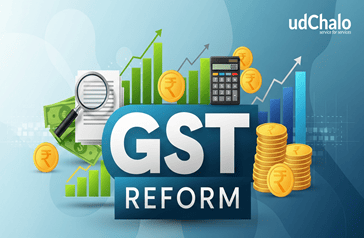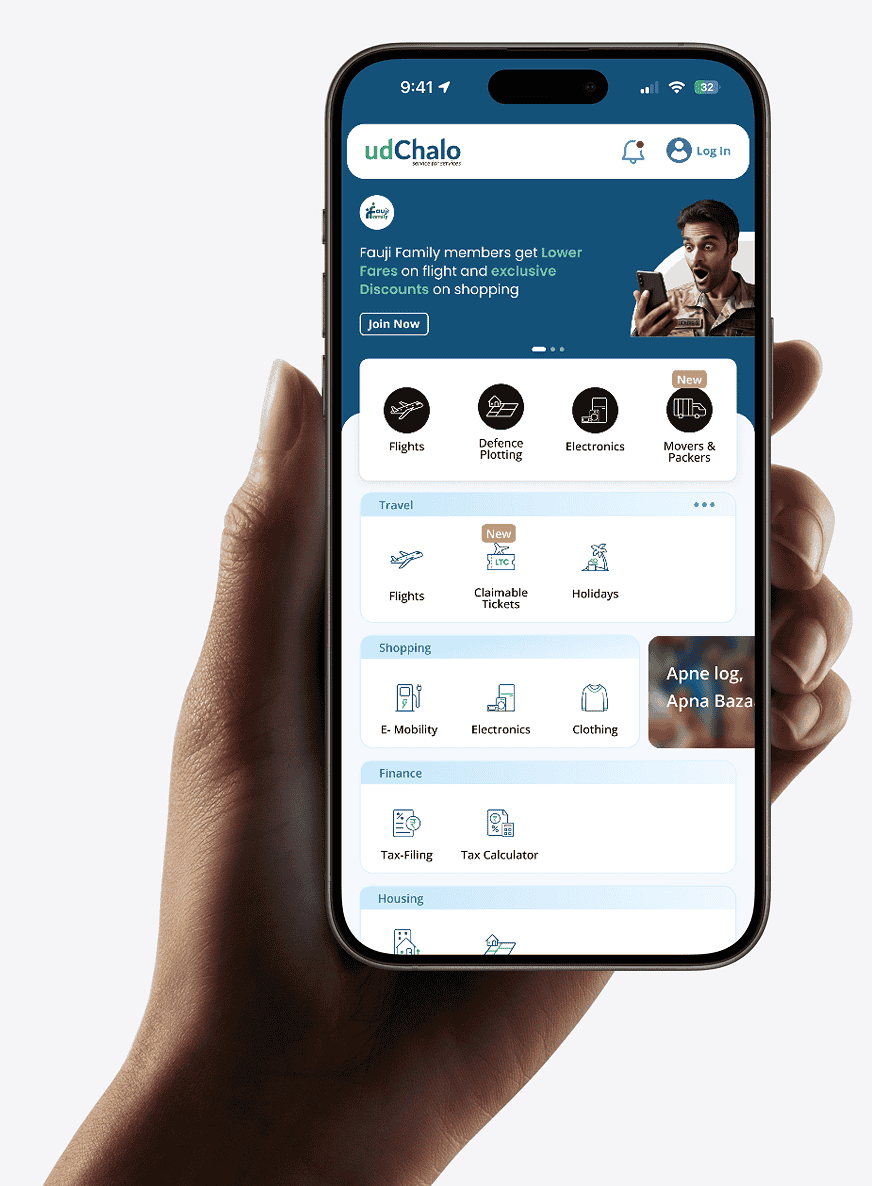What are TIS and AIS in Income Tax? A Complete Guide for Defence Personnel
Key Highlights
- Know the difference between TIS and AIS in Income Tax.
- Learn how to use these reports for accurate tax filing.
- Simplified guide tailored for defence professionals, veterans, and families.
- Common errors and how to avoid them using AIS and TIS.
- Access affordable CA-assisted tax filing plans from udChalo.
Why Should Soldiers Understand AIS and TIS?
As a defence professional, your financial records might include multiple income sources such as salary, pension, allowances, retirement benefits, and interest from savings. Managing taxes for these can get complex.
The Income Tax Department has introduced two key tools to help:
- AIS (Annual Information Statement)
- TIS (Taxpayer Information Summary)
These help you cross-verify your income, avoid errors, and file taxes correctly. Let us explore these in detail, simplified for defence personnel, veterans, and their families.
Read More: Common ITR Filing Mistakes To Avoid in AY 25-26
What is AIS in Income Tax?
The Annual Information Statement (AIS) is a digital record of your entire income and tax-related activities for a financial year. It includes:
- Salary and pension income
- Interest earned from banks or post office
- Dividends
- Mutual fund transactions
- Property purchases or sales
- TDS details
You can download your AIS from the Income Tax portal and use it to double-check all entries before filing your tax return.
Example: If you have earned interest on your Defence Salary Account and a Fixed Deposit, both will appear in your AIS.
What is TIS in Income Tax?
The Taxpayer Information Summary (TIS) is a condensed version of AIS. It summarises:
- Total taxable income
- Tax deducted
- Reported and processed values
TIS is especially useful when you are reviewing the pre-filled details in your ITR (Income Tax Return). It helps you avoid mistakes and ensures smoother filing.
AIS vs TIS: What is the Difference?
Here is a quick comparison table to help you understand the difference:
Feature | AIS (Annual Information Statement) | TIS (Taxpayer Information Summary) |
|---|---|---|
Detail Level | Extensive data | Condensed summary |
Format | PDF / JSON | PDF only |
Purpose | Detailed transaction history | Quick summary for ITR filing |
Editable? | No | No |
Where to Find | Income Tax Portal | Income Tax Portal |
Who Should Use It? | All taxpayers | Taxpayers preparing to file ITR |
Why AIS and TIS Matter for Defence Personnel
As a serving soldier or a retired veteran, you may receive:
- Salary from multiple postings
- Pension from CDA or banks
- Disability pension or allowances
- Arrears or leave encashment
These often get reported under different heads, and the AIS and TIS may reflect mismatches or duplications.
Tip: Always compare your AIS and TIS with your Form 26AS and salary slips to avoid incorrect tax calculations.
How to Access Your AIS and TIS (Step-by-Step)
Follow these simple steps to access your AIS and TIS on the Income Tax portal:
- Go to: https://www.incometax.gov.in
- Login using PAN and password
- Go to "Services" then "AIS"
- Choose the Assessment Year
- Download both AIS and TIS (PDF or JSON)
Once downloaded, carefully review entries such as:
- Salary (from CDA or bank)
- Pension income
- Interest from Defence Salary Account
- TDS by banks or employers
Jargon Simplified: What Do These Tax Terms Mean?
Term | Meaning |
|---|---|
TDS | Tax Deducted at Source by employer or bank |
PAN | Permanent Account Number |
AY | Assessment Year, the year following the financial year |
Form 26AS | Annual tax credit statement |
ITR | Income Tax Return |
CDA | Controller of Defence Accounts |
Pre-filled ITR | Auto-filled ITR form based on your records |
Read More: What is Form 26AS? Why is it important for Tax Filing?
Common Errors in AIS and TIS: How to Fix Them
Common Mistakes
- Same interest income shown twice
- Pension reflected as salary
- Missing income from short-term postings
- Incorrect PAN linkage across accounts
How to Fix
- Use the Feedback option in AIS to raise corrections
- Attach bank statements or salary slips if required
- Or get help from a CA through udChalo’s assisted tax filing services
Read More: Last Minute Tax Saving Tips
Dos and Don’ts When Reviewing AIS and TIS
Do:
- Download and check both AIS and TIS before filing ITR
- Compare them with Form 26AS and salary slips
- Report discrepancies immediately using AIS feedback
- Use expert help if unsure
Don’t:
- Assume AIS is always 100 percent accurate
- Ignore minor mismatches, they can trigger scrutiny
- Share AIS files over WhatsApp or public platforms
Tips for Defence Personnel
- Download AIS in May or June, once banks upload final data
- Veterans should check if pension is reflected under the correct income head
- Serving officers should validate salary from multiple departments
- Spouses should report rental, FD, or investment income carefully
- Consider CA-assisted ITR filing for higher tax slabs or multiple incomes
How udChalo Helps You File ITR with Ease
udChalo understands the financial realities of soldiers and veterans. That is why their CA-assisted Income Tax Return Filing Plans are designed just for you.
- Choose from Basic to Premium plans
- Experts review AIS, TIS, Form 26AS, and ITR
- Get help with pension, disability allowance, gratuity and exemptions
- Plans start at just ₹199
Explore udChalo CA Filing Plans
Final Thoughts: Stay Informed, File Confidently
Filing taxes can be overwhelming, especially when you have multiple income sources and exemptions to manage. The AIS and TIS make this process simpler and more accurate. They help you avoid errors, ensure compliance, and file with confidence.
If you are not sure how to proceed, let udChalo’s expert CA partners handle your filing needs. Focus on your duties or enjoy your well-earned retirement while we take care of your taxes.
FAQs
1. What is the Annual Information Statement (AIS) in Income Tax?
The AIS is a report issued by the Income Tax Department. It shows all your income-related activities for the year, such as salary, pension, interest, property transactions, and TDS. It helps defence personnel and veterans cross-check income reported by banks and employers before filing their ITR.
2. What does TIS mean in the context of income tax filing?
The Taxpayer Information Summary (TIS) is a summarised version of your AIS. It provides a ready-to-use view of income, tax deducted, and other values that match your ITR form. It is especially useful for quickly verifying the information before submitting returns.
3. Why is AIS important for defence personnel?
AIS captures incomes from CDA, pensions, interest from Defence Salary Accounts, and allowances. Defence personnel often change postings and have multiple income heads. AIS consolidates these, reducing the risk of tax errors.
4. Can retired soldiers and veterans use AIS for tax filing?
Yes. Veterans should use AIS to verify pension credits from banks or post offices, TDS deducted, and any rent or investment income. TIS further helps simplify this when preparing their return.
5. How does TIS help during ITR filing?
TIS provides a summarised view of all income and tax deducted. It also shows reported versus processed values. For example, if your employer reports a higher salary than what you received, this will show up in TIS, allowing you to get it corrected before ITR submission.
6. How can I correct errors in my AIS?
If there is a wrong entry in your AIS, such as duplicate income or incorrect salary data, you can raise a correction through the AIS Feedback section on the Income Tax portal. You may need to upload supporting documents. If unsure, you can use udChalo’s CA-assisted filing service for expert help.
7. Is AIS the same as Form 26AS?
No. Form 26AS primarily displays TDS and tax credit details. AIS offers a broader view of your financial activity, including interest income, investments, property sales, and more. It complements but does not replace Form 26AS.
8. Can I file taxes without checking AIS and TIS?
You can, but it is not advisable. Filing without checking these may lead to errors, mismatches, or scrutiny. Defence families, especially those with multiple incomes, should always review AIS and TIS or opt for expert help.
9. How is udChalo helping defence families with ITR filing?
udChalo offers CA-assisted plans tailored for soldiers, ex-servicemen, and their families. Their experts understand defence-specific incomes, exemptions, and challenges, ensuring correct and easy tax filing for you.
10. When should I check my AIS and TIS?
Ideally, check your AIS and TIS in May or June, once all data from banks and employers has been uploaded to the portal. This ensures you are working with complete information before the ITR deadline, usually July 31.
Related Articles

The Next-Gen GST Reform 2025 brings significant tax relief across essentials, healthcare, farming, education, automobiles, and electronics. Here’s a complete breakdown of what’s cheaper and how it supports soldiers, veterans, and families.

This Navratri and Diwali, India celebrates with savings thanks to the Next-Gen GST Reform 2025. Electronics, cars, and real estate are now more affordable, benefiting both civilian and defence families.

Timely filing of your return isn’t just about avoiding penalties. It can also help you earn more through interest on your tax refund. Here’s why the 15 September 2025 deadline is critical for boosting your refund.
Related Post

The Next-Gen GST Reform 2025 brings significant tax relief across essentials, healthcare, farming, education, automobiles, and electronics. Here’s a complete breakdown of what’s cheaper and how it supports soldiers, veterans, and families.

This Navratri and Diwali, India celebrates with savings thanks to the Next-Gen GST Reform 2025. Electronics, cars, and real estate are now more affordable, benefiting both civilian and defence families.

Timely filing of your return isn’t just about avoiding penalties. It can also help you earn more through interest on your tax refund. Here’s why the 15 September 2025 deadline is critical for boosting your refund.








